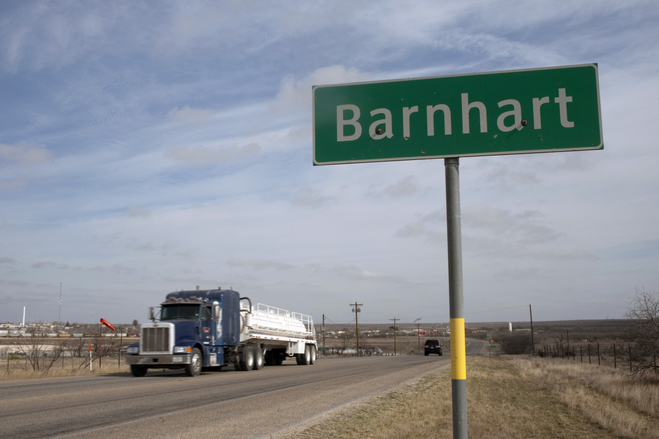Podcast: Play in new window | Download
Subscribe: RSS
Barnhart, Texas, a crossroads village 250 miles southwest of Dallas, is living the dream. It was barely hanging on to a sleepy, sunbaked existence when fracking came to the area two years ago. As drill rigs sprouted like Jack’s beanstalks in every direction and oilfield workers swarmed in RV suburbs, the town boomed, and some property owners in the area landed rich leases. “Boom Times for a Tiny Texas Town,” exulted the Wall Street Journal. Last month, the entire town ran out of water. Bust.
Barnhart, Texas, is now living the nightmare.
It had already happened to a lot of ranchers and farmers in the area who thought the boom would make them rich. But irrigation water ran out, and the cotton crops were decimated. Water for cattle ran out, and entire herds have been sold off. One formerly prosperous rancher (500 cattle and 8,000 goats on 20,000 acres) was dismayed when frackers who leased oil rights to part of his land drilled 104 water wells. All he can water now is about 100 goats. He’ll be even more dismayed when the oil wells peter out in another couple of years, and he loses that income too, with no way to go back to ranching. Bust, again.
Fracking (hydraulic fracturing, which uses water and chemicals to blast oil and natural gas out of shale deep underground) is a thirsty business. It takes millions of gallons of water to frack a well, and once it is turned into a witches’ brew of toxic chemicals it cannot be used for anything else. Much of it is disposed of by blindly injecting it deep into the ground. [See “Aquifer Pollution: Out of Sight, Out of Our Minds.”]
Finding enough water to keep fracking going is a problem anywhere, anytime, but much of Texas has been in severe drought conditions for three years now, with no sign of relief in sight, but one thing that does not wither in drought is greed. Signs along the roads from Barnhart offer fresh water for sale by the tanker-truckload. One entrepreneur who owns enough land to get a pipe down to the aquifer plans on making $36,000 a month selling water for oil.
The Texas Commission on Environmental Quality expects 30 communities to run out of water this year. Towns such as Robert Lee [See: “A Town in Texas: This is How it Ends“] and Spicewood Beach already have, and live at the mercy of convoys of water trucks. While in and around Barnhart, the water convoys are still serving the drilling rigs.
The town was totally out of water for five days. Then they kick-started an old abandoned well, and got a very temporary stay of execution for the town. “When the water runs out,” says a resident, “that’s it. We’re gone.”
At least, when they become water refugees, they can take some comfort from the fact that they contributed to lower gasoline prices and energy independence for their countrymen. Oh, wait….
-0-
[The only non-local source I know of for this story — “A Texan tragedy: ample oil, no water” — and frequently the only source of coverage for the dark side of industrial exploitation in America, is The Guardian newspaper. It’s in England.]

That’s pretty terrible news for the town. How was there not indication that the required water levels wouldn’t be enough. I mean to run an entire area dry? Isn’t testing done to ensure operations will continue in the long run?
No. No one is thinking about the long run, only the quick buck.